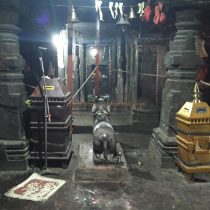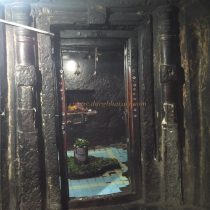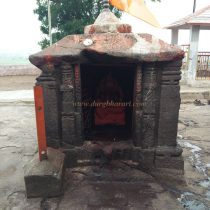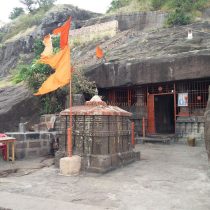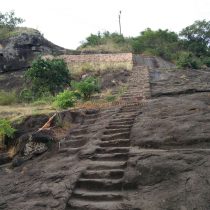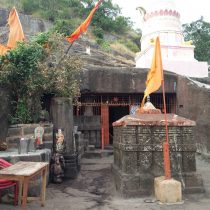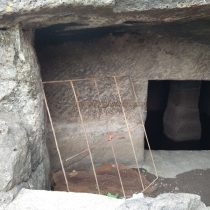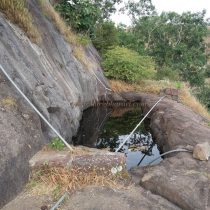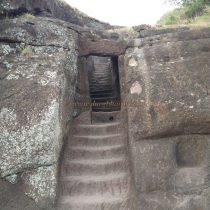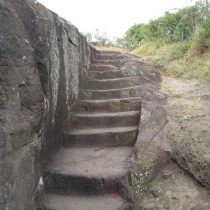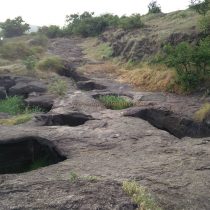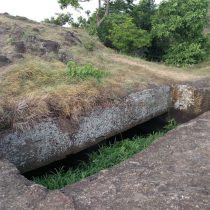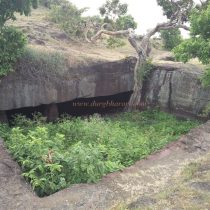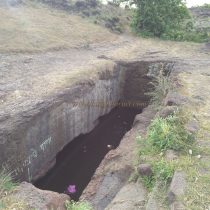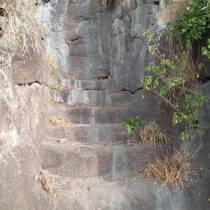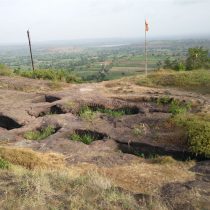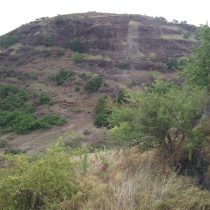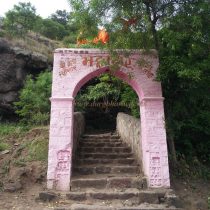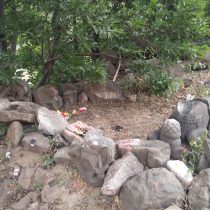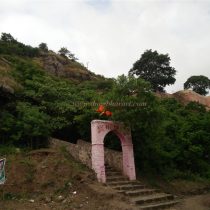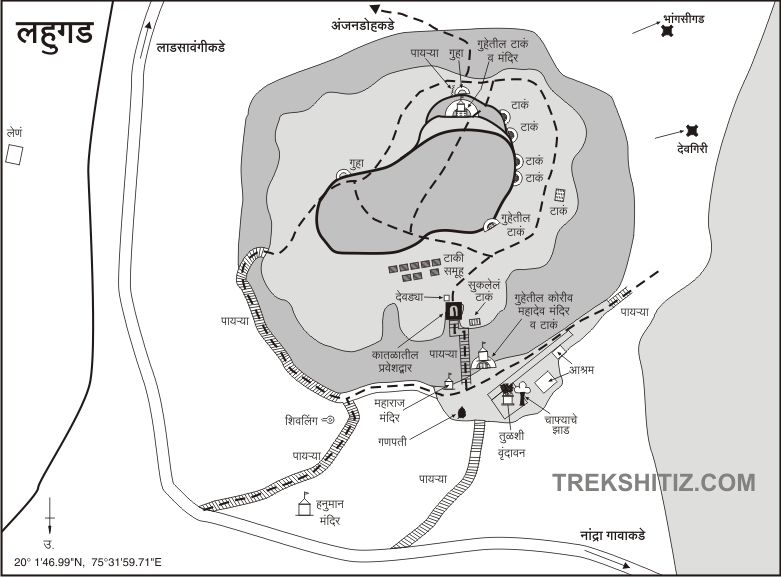LAHUGAD
type : HILL FORT
DISTRICT : AURANGABAD
HEIGHT : 2565 FEET
GRADE : EASY
Lahugad is a fort situated in the range of the Ajanta-Verul caves hills. The fort must have been built to keep an eye on the ancient route that passes through Devgiri and the famous Ajanta Caves. The height of this fort is 2500 feet above sea level and the fort is only 1200 feet above the base. The fort has a total area of 5 acres, is 550 feet long and 400 feet wide. Located in Aurangabad district, this small fort is about 40 km from Aurangabad city. Fulambri village is at a distance of 29 km from Aurangabad on the Aurangabad-Jalgaon road which leads to Ajanta Caves. Palphata is 4 km away from Phulbari. Turning right at this fork of Palphata, we proceed further on Rajur Road. Jategaon is at a distance of 9 km from Palphata on this road. Nandra is a village at the base of the fort, 4 km from Jategaon.
...
Lahugad is 3 km behind Nandra village. As soon as you reach the fort, you can see Lahugad separated from the hill due to the gorge of the hills on both sides. Lahugad is under the control of Rameshwar Mandir Samiti. This committee has built a paved road to the base of the fort and steps to reach the fort. There is a very old Banyan tree where your car stops at the base and there is a temple of Hanuman next to it. In front of this temple, there is a stone arch inscribed with the text Shri Kshetra Rameshwar, Mahadwar, Lahugad Nandra. At the bottom of this arch, two hero stones are constructed. The steps of the fort start from this arch. Go up a few steps and you will see an excavation like a water cistern on the left side. It has a Shivling and Nandi. After climbing a few steps, we come to a plain surface. There is an ancient idol of Lord Ganesha under a tree on the right side. This is the original idol of the temple on the fort and due to wear and tear, another idol of Lord Ganesha has been installed in its place. The Samadhi temple of the sadhu on the fort is built on the right side here. From here our real trekking of fort start & true adventure begins! In front of the temple, steps are carved in the rock to reach the top of the fort. But before you go there, you should explore the area on the plain surface. Next to the steps is a beautiful cave temple known as Rameshwar or Rudreshwar. The entire cave temple has many carvings. In front of this cave temple is a 5 feet high domed temple completely carved out of the rock. The temple has a newly installed idol of Lord Ganesha and many ancient carved idols can be seen in the cave temple. In the facade of the cave temple, there is a large pillared water cistern carved in the rock. Although the water in the cistern looks clean from the outside, the water inside smells foul. the gutter is carved on the rock so that the water falling on the cave temple does not seep in and get collected into the cistern. There are two circular pillars carved in the facade of the cave temple and the door of the temple is also carved here. The windows are carved on both sides of the door and there are many carvings on the door. The sabha mandap of the temple and the sanctum sanctorum are completely carved in the rock and the sabha mandap is weighed on 4 carved pillars. Shivling has been installed in the sanctum sanctorum and Nandi has been placed in the hall. The interior of the temple has many carvings, with rooms carved, one of which is in front of the sanctum sanctorum and one next to it. A new cement dome has been built on the upper part of the temple. Going towards the valley in the next part of the temple, you can see the remnants of the ramparts. From here, there is a path to go to the hill in front. After seeing this part of the fort, you should come to the path of the steep steps. Going up this path, the steps turn left and there are cisterns filled with green water on the right side. Going up a few more steps, you come across a small gate of the fort carved out of the rock. This door which is more like a tunnel is made inside a mountain, beyond the door is a cave is carved on the left side. This cave must have been used to house the guards. Next, turn right and climb a few steps to reach the top of Lahugad. The head of Lahugad is still intact and there are pillars, cisterns, and caves carved into the rock on almost all sides of the fort. There is a group of 8 cisterns in front of the fort through which you enter the fort. Some of these cisterns have water in them and some of them are just overgrown with bushes. Seeing these cisterns, you should start your fort round from the right side. At the beginning of the road, there are pillared water cisterns carved in the ground and at present, the same water is used for drinking on the fort. Next are 6 water cisterns carved in a line. In front of these cisterns is a cistern filled with trees and by turning from this cistern we come to the back of the fort. There is a large cave carved in the rock. This cave is perfect for camping and there is a pillar on one side of the cave. There is a small door to enter this one pillared cave and 3 windows are carved for air ventilation on the side. A little further from the cave, there is a broken entrance at the back of the fort, ramparts, and an old stone staircase descending. This road leads to Anjandoh village. Instead of going down this path, we would come back to the cave and climb the steps carved in the rock that goes up next to the cave. After climbing up from here you will see a temple carved in the rock in a hollow area in front of us. This is called Sita Nhani. The temple has a female idol carved in stone. A pillar is carved on the side of the temple. Descending from here on the right, another wide cave carved in the rock can be seen. From this cave, a path leads to the Hanuman Temple at the foot of the fort. There is only one water cistern on the way back to the entrance of the fort. On the surface at the top of the fort, you can see quadrangle structures of some houses. Since our fort round has been completed here, we can reach the base of the fort by this second route or descend from the Rameshwar temple. Although there are more than 20 water cisterns on the fort, only 1-2 cisterns have potable water. Even if Lahugad is small in size and easy to climb, to see all the remains properly it takes about two hours. The history of Lahugad is not available but looking at the cisterns carved in the rock, caves, and its proximity to the fort of Devagiri, this fort must have existed since ancient times. Accommodation and drinking water are available in the temples and caves on the fort. The hill to the left of Lahugad is known as Chambar Hill. There are 3 caves carved at the foot of this mountain and it takes about half an hour to visit these caves and return.
© Suresh Nimbalkar

